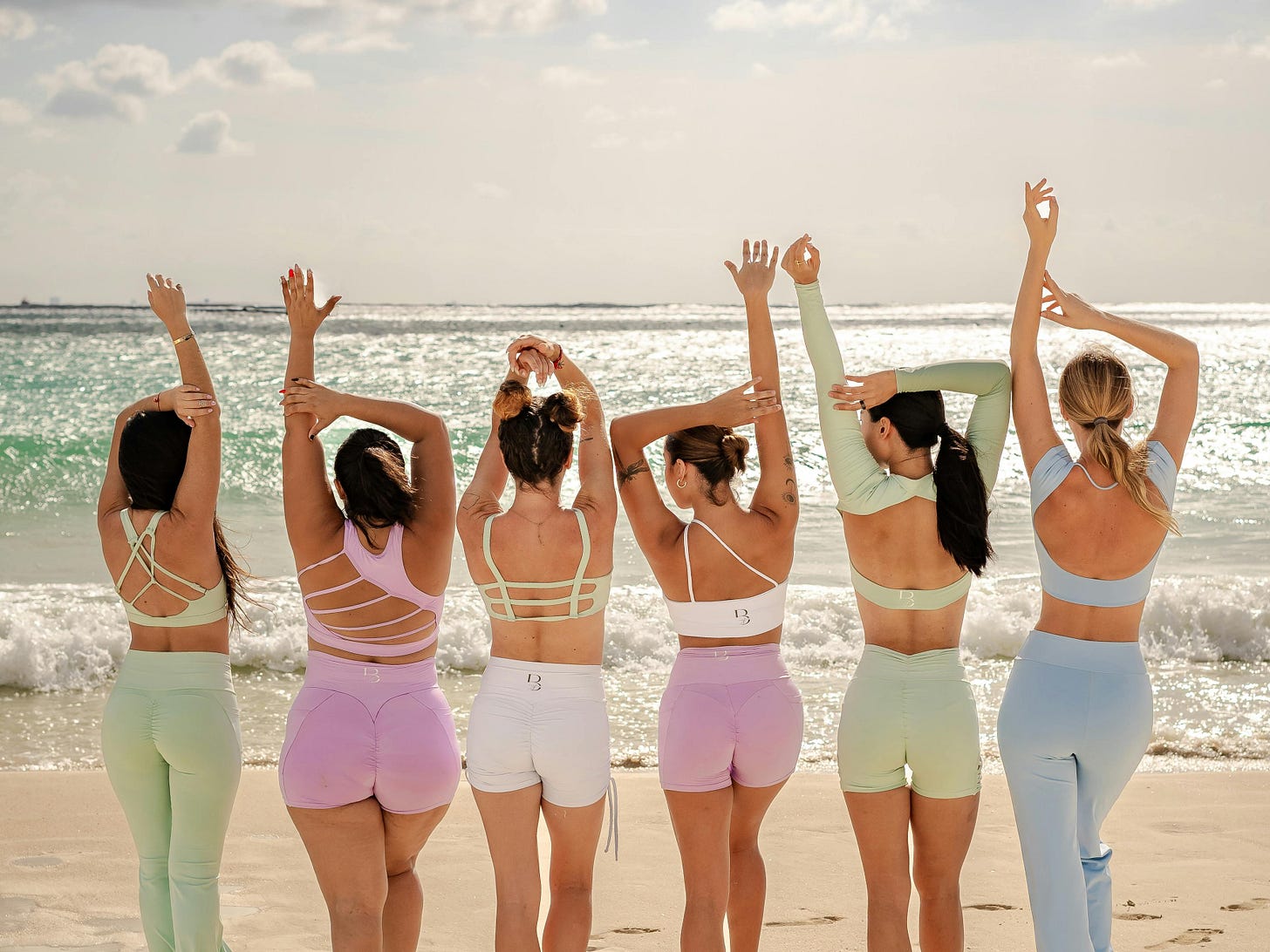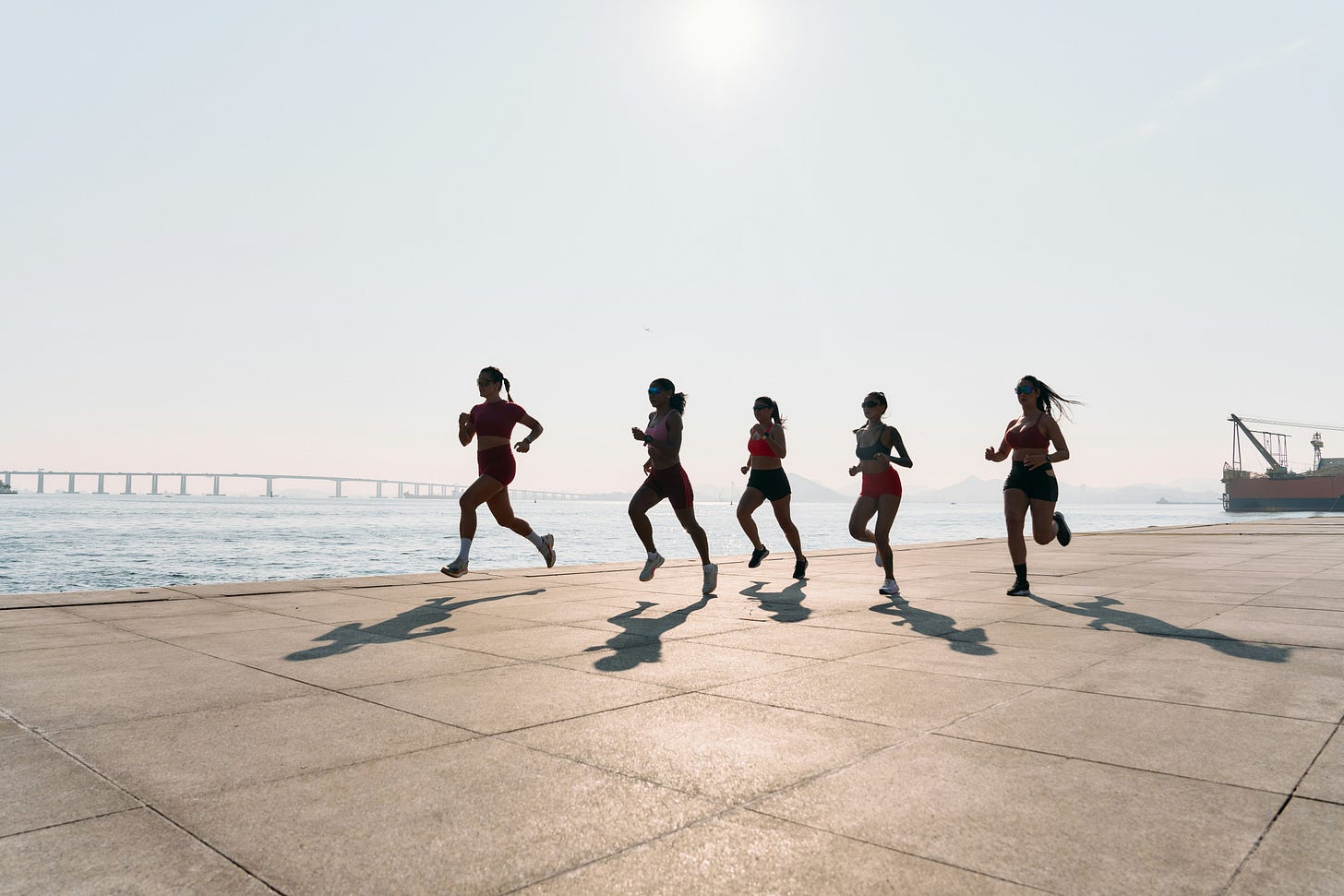The Community Runs That Are Changing Wellness Culture for Women
Monday Glow Feature
There’s an unmistakable buzz in city parks and trails — not just the rhythmic pounding of sneakers on pavement, but a collective heartbeat of women coming together to run, laugh, and reclaim wellness as a shared, social journey. These female-focused community runs are quietly revolutionizing how women experience health, dismantling long-standing wellness isolation and reshaping the cultural narrative around fitness and belonging.
In today’s column, we’re exploring the rise of female community runs — and why they’re quietly reshaping modern wellness culture. From reclaiming public space to shifting the way we approach fitness, these gatherings are more than just movement—they’re medicine for the isolation so many women feel in their wellness routines. We’ll break down the cultural shifts, the science of belonging, and how wellness brands are responding—plus, for premium members, we’ve created a luxe starter kit to help you launch or find your own community run.
Not a premium member yet?
Wellness today is paradoxical. We have more access than ever to fitness studios, apps, wearables, and curated solo rituals, yet feelings of isolation within these pursuits are skyrocketing — particularly among women.
Research reveals a striking loneliness paradox in wellness:
Solo exercise, while physically beneficial, often fails to address the emotional and social dimensions of health.
A 2021 study published in Health Psychology found that individuals exercising in social settings reported greater psychological well-being and motivation than those exercising alone.
Women are particularly vulnerable to wellness-related isolation, with societal pressures compounding feelings of needing to “do it all” alone, without visible support systems.
The rise of digital wellness content — Instagram workouts, YouTube fitness challenges, and personalized coaching apps — while empowering, can paradoxically reinforce the myth that health is a solitary climb. The hyper-individualized culture of “wellness hustle” glorifies solo achievements, often overlooking that human beings are inherently social creatures whose health thrives in community.
In response, women across the globe are forming vibrant, female-only running clubs that emphasize connection as much as performance. These aren’t just running groups — they’re communities where wellness is a collective experience rooted in belonging, safety, and empowerment.
Why do these groups resonate so deeply?
Safe and supportive environments: Many women cite feeling safer running in a group, especially in urban or less familiar spaces, reducing anxiety and opening the door to more consistent exercise.
Accountability that sticks: Shared schedules and mutual encouragement boost motivation. Group members are 30% more likely to stick to exercise routines than solo exercisers, according to a 2020 Journal of Sport and Exercise Psychology meta-analysis.
Emotional nourishment: Group runs foster deep social bonds — a sense of sisterhood where women can openly share challenges, celebrate milestones, and mentor one another.
Inclusivity and diversity: Many clubs focus on welcoming all fitness levels and backgrounds, dismantling competitiveness in favor of communal support.
For example, groups like She Runs This Town and Girls on the Run have scaled nationally by nurturing localized, accessible communities — creating safe spaces where women feel seen, heard, and empowered.
Wellness is often marketed as a physical transformation, but the emotional and mental layers are equally critical — especially for women who face unique social and psychological challenges.
Community runs disrupt isolation by:
Combating loneliness and depression: Regular social exercise has been linked to reduced symptoms of anxiety and depression. The social endorphin release during group activities supports mood regulation far more effectively than solitary exercise.
Building mental resilience: Sharing a challenging run cultivates collective grit — participants learn to push through physical discomfort knowing others are with them. This shared struggle fosters emotional strength transferable beyond fitness.
Creating social identity and belonging: Humans crave belonging; group running offers a tangible identity tied to community, boosting self-esteem and life satisfaction.
Women in these clubs often describe their runs as “therapy on the move” — spaces where mental fog lifts and social connection ignites renewal. It’s a wellness reset that solo workouts rarely replicate.
While the physical benefits of running are widely celebrated, the science behind why group runs amplify these benefits—especially for women—is both fascinating and instructive. Understanding the physiological and psychological mechanisms at play reveals how community running forms a uniquely potent wellness formula.
Group exercise is essentially a neurochemical dance that engages brain systems responsible for bonding and pleasure. When women run together, several powerful biochemical pathways activate:
Oxytocin Release — The “Bonding Hormone”: Often dubbed the hormone of connection, oxytocin fosters trust, empathy, and social bonding. Research shows that shared physical activity, like running in a group, stimulates oxytocin release more than solitary exercise. This hormone reduces anxiety and increases feelings of safety—critical for women navigating public spaces and social vulnerability.
Endorphins — Nature’s Mood Lifters: Running triggers endorphin release, the body’s natural opioids that reduce pain perception and produce a euphoric “runner’s high.” Group contexts amplify this effect. Shared laughter, encouragement, and synchronized movement synchronize brain waves and boost endorphin output, creating a collective mood lift that transcends what solo runs can achieve.
Dopamine and Serotonin Synergy: Beyond oxytocin and endorphins, social exercise engages dopamine pathways (reward and motivation) and serotonin systems (mood regulation). The anticipation of a social run, the shared effort, and the post-run camaraderie all contribute to heightened motivation and sustained mood balance.
This neurochemical cocktail creates a reinforcing loop—women seek connection, group running releases bonding chemicals, which in turn increase desire to maintain the behavior. It’s a virtuous cycle fueling wellness and social connection simultaneously.
For women, whose hormonal cycles are intricate and influenced by internal and external stressors, group running provides multifaceted hormonal benefits:
Cortisol Regulation: Cortisol, the primary stress hormone, follows a natural circadian rhythm but spikes sharply under chronic stress, leading to negative health outcomes like fatigue, immune suppression, and weight gain. Exercise reduces cortisol, but studies indicate social support during physical activity further blunts cortisol responses, buffering the body against the deleterious effects of stress. For women juggling career demands, family responsibilities, and societal expectations, this modulation is critical for maintaining resilience.
Estrogen and Progesterone Stability: Female sex hormones influence mood, energy, and physical wellbeing cyclically. Group exercise positively impacts hormonal balance by promoting regular physical activity with emotional support, which helps stabilize fluctuations linked to PMS, perimenopause, and mood disorders. The psychosocial support intrinsic to group runs reduces psychological stress, indirectly supporting endocrine health.
Inflammatory Markers and Immune Function: Chronic stress elevates inflammation, a contributor to many chronic diseases. Social engagement during group runs has been associated with reduced markers of systemic inflammation, possibly mediated by hormonal pathways, further underscoring the holistic benefits of this practice.
One of the greatest hurdles in fitness is consistency — and here, group running delivers remarkable advantages:
Social Accountability as a Motivator: Humans are wired for social reciprocity. Knowing that others expect your presence taps into deeply ingrained social motivations, making women significantly more likely to adhere to exercise routines. Empirical studies report up to a 50% increase in attendance rates for group-based exercise programs compared to solo efforts.
The Social Facilitation Effect: First identified in social psychology, this phenomenon describes how individuals perform better in the presence of others. In running groups, this manifests as increased pace, endurance, and effort. The friendly competition and collective encouragement raise performance thresholds, enabling women to achieve greater fitness gains and satisfaction.
Psychological Enjoyment and Reduced Perceived Effort: Group dynamics often make workouts feel easier and more enjoyable, reducing perceived exertion. Enjoyment is a key predictor of long-term exercise adherence, and this is especially powerful when women connect emotionally during group runs.
Safety concerns—both physical and psychological—are a significant barrier for many women considering outdoor exercise:
Reduced Perceived and Actual Safety Risks: Running in groups enhances vigilance and deters harassment or assault, a reality supported by urban safety studies. The presence of others fosters a “safety in numbers” effect, increasing women’s willingness to run early mornings or after dark.
Encouraging Broader Participation: Knowing a run is socially supported and safe encourages women across fitness levels and backgrounds to participate, broadening accessibility. This inclusion fosters diversity in wellness communities, enriching social capital and collective empowerment.
Psychological Safety and Belonging: Group runs create “safe spaces” where women feel emotionally secure to share vulnerabilities and triumphs. This psychological safety enhances mental health and encourages risk-taking in fitness challenges, propelling growth and resilience.
These scientific insights reveal that group running transcends the sum of its parts. It crafts a holistic ecosystem where physical exertion, emotional wellbeing, hormonal balance, and social connection converge. For women, especially, this integrated model of wellness—where community is central—supports not just fitness, but a sustainable, joyful, and resilient approach to health.
This understanding reframes wellness culture: success is no longer measured solely by individual metrics or milestones, but by the strength of the community and the depth of connection women experience along the journey.
Women’s community running groups are much more than fitness trends; they represent a meaningful cultural shift that challenges how wellness and public space have traditionally been experienced and perceived. These groups offer new ways to connect, move, and thrive — reshaping the broader wellness landscape with fresh values rooted in community, safety, and empowerment.
Public spaces like parks, streets, and trails have often felt inaccessible or unsafe for many women, especially when exercising alone. The rise of female-focused running groups is changing that dynamic in impactful ways:
Visibility as Empowerment: Running together in groups allows women to claim space confidently and visibly. This collective presence challenges social norms that have historically limited women’s freedom in public environments. The simple act of running en masse transforms streets and parks into arenas of empowerment and community.
Safety in Numbers: Safety is a major concern for many women when exercising outdoors. Group running reduces risks and alleviates fears, creating environments where women feel secure and supported. This enhanced safety encourages more consistent engagement with outdoor fitness, extending the hours and areas women feel comfortable in.
Freedom for Authentic Movement: Group runs foster spaces where women can move freely without judgment, expectations, or pressure. The supportive atmosphere nurtures individual expression and joy in movement, encouraging participation across all levels and backgrounds.
This reclamation of public space through community runs transforms not only the physical landscape but also the social and psychological relationship women have with their environment.
These running groups exemplify an evolving wellness culture that values connection and shared experience over individual achievement and competition. They create spaces where wellness is understood holistically — physical, mental, and social health interwoven.
Collaboration Over Competition: Rather than a solo grind toward fitness milestones, these communities emphasize mutual support and collective motivation. This collaborative mindset nurtures sustainable wellness habits and reduces burnout.
Inclusivity and Diversity: Many female running groups prioritize welcoming all women, regardless of fitness level, age, or background. This inclusivity helps dismantle narrow wellness ideals and builds richer, more diverse communities.
Shared Energy and Accountability: The social energy of group runs creates momentum that drives commitment and enjoyment. Women report feeling more motivated and less isolated, making wellness a joyful, collective experience.
This shift moves wellness culture toward a more balanced, human-centered approach — one that honors belonging as a critical ingredient of health.
Mainstream wellness culture often emphasizes productivity, measurable results, and self-optimization. This “wellness hustle” mindset can inadvertently increase pressure and stress.
Community running groups offer an alternative:
Joyful Presence: Group runs focus on shared experience and the present moment rather than solely on metrics or competition. This presence fosters mindfulness and deepens enjoyment of movement.
Sustainable Practice: The social bonds formed provide emotional support that encourages consistency and resilience — key factors in long-term wellness success.
Balance Over Perfection: These communities promote acceptance, allowing women to move at their own pace and celebrate progress without pressure to conform to idealized standards.
This reframing encourages a wellness culture rooted in care, connection, and sustainable habits rather than relentless self-optimization.
Beyond individual benefits, these groups function as vital hubs where wellness, social connection, and empowerment intersect:
They cultivate networks of support that enhance emotional wellbeing and foster resilience.
They provide opportunities to build meaningful relationships that extend beyond fitness, enriching broader life domains.
By transforming urban spaces and wellness culture alike, they demonstrate how collective movement can inspire cultural shifts toward inclusive, connected health.
Every run taken together becomes an act of reclaiming not just space but a richer, more connected wellness experience — one where community is central to thriving.
As women’s community running groups gain momentum and reshape wellness culture, the fitness and wellness industry is responding with strategic shifts that reflect both cultural demand and commercial opportunity. This evolution signals a deeper alignment with values of connection, inclusivity, and sustainable wellbeing — moving beyond transactional fitness toward cultivating authentic belonging.
Fitness technology has long prioritized individual tracking and performance metrics, but now leading platforms are pivoting to embrace social engagement, especially for female users:
Nike Run Club and Strava have integrated features specifically designed for group runs and women-centered challenges. These include the ability to create women-only groups, organize virtual meetups, and participate in supportive, non-competitive community challenges. By fostering connection through technology, these apps help women overcome the barriers of time, location, and isolation.
These platforms also use data analytics to provide personalized community recommendations, matching users with local running clubs or virtual groups aligned with their fitness levels and interests. This fusion of personalization and community taps into modern women’s desire for both tailored wellness and social belonging.
Virtual communities and group challenges further bridge the gap between solo workouts and social connection — enabling women to engage in shared goals regardless of geography or schedule.
The wellness industry’s physical footprint is also evolving to support female community fitness in new and thoughtful ways:
Boutique studios and gyms increasingly offer women-only running clubs, often integrated with expert coaching and social events like post-run brunches or wellness workshops. These environments foster a sense of belonging while providing structure and motivation.
Wellness centers are designing programming that prioritizes inclusivity, community-building, and emotional support — moving away from purely performance-focused models. This holistic approach resonates deeply with women seeking wellness experiences that nurture mind and body together.
On a broader urban scale, local governments and parks departments are responding to women’s safety concerns by improving infrastructure: enhanced lighting, more visible patrols, and community-driven safety initiatives. These changes make outdoor running routes more accessible and appealing to women, encouraging greater participation in public wellness activities.
Community feedback loops have become central in designing these spaces — ensuring that women’s voices inform everything from route planning to scheduling group events, thus reinforcing the relationship between wellness culture and place.
The wellness industry’s marketing strategies are evolving from aspirational individualism toward narratives grounded in community and authenticity:
Brands are telling stories that highlight connection, shared experience, and support networks rather than solitary triumphs. Campaigns increasingly feature diverse women in group settings, showcasing real moments of camaraderie and empowerment.
This shift responds to a growing cultural appetite for wellness that feels accessible, sustainable, and socially enriching — rejecting the exclusivity and isolation sometimes perpetuated by traditional fitness marketing.
By positioning community at the core, brands foster deeper emotional engagement and brand loyalty. Consumers today value authenticity and shared values, making this evolution both culturally significant and commercially savvy.
This strategic pivot toward supporting female running communities is more than a trend; it reflects a broader reimagining of wellness as fundamentally social and interconnected:
It challenges the fragmented, individualistic wellness models that have dominated the past decade.
It elevates belonging as a core pillar of health, recognizing that connection is essential for motivation, consistency, and emotional wellbeing.
It opens new pathways for innovation — from hybrid digital-physical programs to safety-focused urban design.
Ultimately, it aligns industry priorities with authentic human needs, signaling a promising future where wellness is inclusive, joyful, and community-driven.
The growing embrace of female community fitness by brands and spaces demonstrates how wellness culture is maturing — evolving from isolated achievement to shared empowerment. For women looking to integrate health with connection, this industry evolution is a welcome step forward in making wellness truly accessible and sustaining.
Here’s the Glow Code for this moment in wellness history: True health thrives in community. Wellness is no longer a solo conquest but a shared voyage — one that elevates every woman it touches through connection, safety, and empowerment.






























